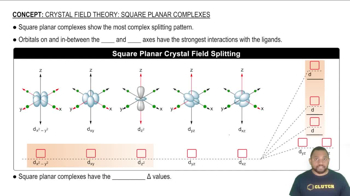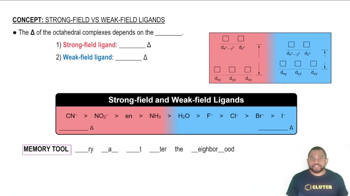Sketch the structure of the complex in each of the following compounds and give the full compound name:
d. cis-[Ru(en)2Cl2]
 Verified step by step guidance
Verified step by step guidance


Sketch the structure of the complex in each of the following compounds and give the full compound name:
d. cis-[Ru(en)2Cl2]
The molecule dimethylphosphinoethane [(CH3)2PCH2CH2P(CH3)2, which is abbreviated dmpe] is used as a ligand for some complexes that serve as catalysts. A complex that contains this ligand is Mo(CO)4(dmpe) .
a. Draw the Lewis structure for dmpe, and compare it with ethylenediamine as a coordinating ligand.
b. What is the oxidation state of Mo in Na2[Mo(CN)2(CO)2(dmpe)] ?
c. Sketch the structure of the [Mo(CN)2(CO)2(dmpe)]2- ion, including all the possible isomers.
Carbon monoxide, CO, is an important ligand in coordination chemistry. When CO is reacted with nickel metal, the product is [Ni(CO)4] which is a toxic, pale yellow liquid.
a. What is the oxidation number for nickel in this compound?
b. Given that [Ni(CO)4] is a diamagnetic molecule with a tetrahedral geometry, what is the electron configuration of nickel in this compound?
c. Write the name for [Ni(CO)4] using the nomenclature rules for coordination compounds.